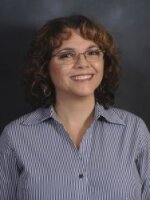As Women’s History Month closes and we look ahead to the July Bicentennial of Escambia County, WUWF is putting the spotlight on Marianna Bonifay. This prominent businesswoman and landowner lived in Pensacola 200 years ago and likely witnessed the ceremonial transfer of the region from Spain to the U.S.
“I’ve always admired Marianna Bonifay,” declared Dr. Judy Bense, who chairs the Escambia County-City of Pensacola 200th Anniversary Committee. “She in a way reminds me of me, or a strong-minded woman in a patriarchal society.”
Dr. Bense, one of the nation’s top historical archaeologists and President Emeritus of the University of West Florida, is explaining why she would like to represent Bonifay in the Bicentennial’s Mosaic Project.
As part of the festivities, the West Florida Genealogical Society is working to identify every living person in Pensacola at the time of the 1821 transfer, and solicit present-day residents to represent them.
“What drew me to her really was her unconventionality. She was ambitious. She had a little money and property and she wanted more,” said Bense. “And, she used that, parlayed that money into development, if you will, in Pensacola. That’s how she met up with Charles Lavalle.”
Lavalle was by Bonifay’s side for many of the nearly 50 years she lived in Pensacola. Born in France in 1760, she moved to Pensacola from New Orleans about 1781, after the Spanish regained control of the city from the British. At the time, she was married to Spanish soldier Joseph Bonifay.
They stayed married until he died in 1801. But, he was absent; he was a military man. And, they had children together while he did not live here and she did, so they obviously met up. The babies were christened and were legal offspring of the two.
But, in Joseph Bonifay’s absence, Marianna took up with Charles Lavalle, who was a much younger man. And, at the time of her husband’s 1801 death, she was pregnant Lavalle’s third child. However, the two never married, as she opted instead to take advantage of her status as a “widow.”
“By being a widow, a woman in Spanish and American, but certainly in Spanish society could own property, could buy and sell property, could be in business, could do almost everything a man could do,” Bense proclaimed.
“So, even though they had four children and they lived together at a very successful brickyard up on Scenic Highway, she continued to be in business. She was in business with her son. She was in business with Charles. She was in business with a lot of people, but it was always as a widow, and therefore, it was legal and accepted.”
Had Bonifay married Lavalle, she could not have continued to operate in this fashion.
“That’s exactly right. Then everything she had would belong to her husband and her husband would make all the business decisions,” explained Bense.
“She was very careful to have her property in her name. Sometimes, it was her maiden name and not her married name of Bonifay."
For example, records show Bonifay bought a house on West Intendencia Street in 1784 – before her husband died - in her maiden name of Mariana Pingrow. At the time, she had five of her 10 children. Some documents show as many as 14 children.
By 1790, Bonifay, who owned several properties, had gone into business with Lavalle, a carpenter and builder. Dr. Bense says they were together as a couple and ran a successful construction and real estate business.

“They would either buy a lot that was vacant, build a house and sell it; or they would buy a rundown house, fix it up and flip. And, they made fine money, enough for her to start a brickyard and it was in her name, not his,” Bense noted. “And, today you would bricks that are stamped with the word (name) Bonifay on them, they’re not uncommon, all over downtown Pensacola.”
According to Bense, Bonifay was a prominent member of Pensacola society, even though she was breaking most conventions of her day and living life on her own terms.
“She found a way to be ambitious, to be in business, to be with the man she wanted, to have children that they both wanted, and yet, remain a respected member of society in 1800-1801,” Bense said.
“In fact, they built this great house in the Bohemia area up on Scenic Highway on the bluffs, and it was a grand place and they even entertained even Gen. Andrew Jackson when he came to town in 1821 with his wife Rachel.”
Bonifay, often referred to as the “Mother of Pensacola,” lived about 8 more years after the transfer of the region to U.S. territory. She died in 1829 at the age of 69. She’s believed to have been buried in Historic St. Michael’s Cemetery, although a marker was never found.
In 1967, her descendants helped to erect a monument to her in the media of Garden Street near the entrance to the cemetery.
“It’s a big monument. It has hundreds of words and it’s basically a short biography of her, and I think that’s great,” declared Bense. “I mean, I will tell you right now that in 2021, I didn’t know that, and I’m going to get out and go look at it.”
Bense also encourages others to go look at the tribute to Marianna Bonifay, who was one of the most independent, prominent women in Pensacola 200 years ago.



